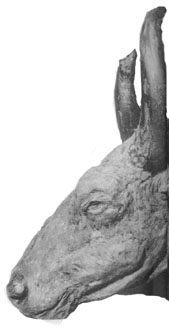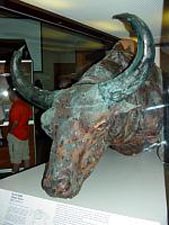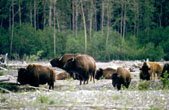Blue Babe, A Messenger from the Ice Age
Blue Babe, A Messenger from the Ice Age
This article appeared in the June 1986 UA Magazine by Gary Selinger
Uncovered during a mining operation, the carcass of an Alaska steppe bison has revealed the story of the animal's Ice Age death to scientists at the University of Alaska Museum on the UAF campus.

Gold miners Walter and Ruth Roman and their sons discovered the carcass in 1979 near
Fairbanks, Alaska. Part of the bison was exposed as water from a hydraulic mining
hose melted the frozen muck in which it was embedded. The miners, realizing the potential
significance of their find, contacted the university.
Paleontologist Dale Guthrie determined the carcass was of an Ice Age bison (Bison
priscus), probably tens of thousands of years old. He decided to excavate immediately
in order to remove the frozen relic before it could deteriorate.
It soon became obvious that the bison carcass could not be excavated quickly because
of frozen ground and the close proximity of large ice wedges. Although high summer
temperatures melted several inches of soil per day, the bison remained frozen in the
vertical bank for some time.
Eventually the carcass hung freely from the bank by the head and neck which were still
embedded in frozen soil. Fearing the thawed portion of the bison would begin to decompose,
Guthrie severed it from the head and neck, transported it to UAF and refroze it. Excavation
of the head and neck continued until they also came free from the muck bank. They
then were stored with the rest of the carcass.

As the frozen soil surrounding the bison melted, they were collected and screen-washed
to expose bone fragments, hair, insects, wood, and plant parts. The surrounding geology,
the orientation and position of the bison carcass, and all material found in association
with it were recorded. This information helped in piecing together the bison's story.
The bison carcass was covered with a blue chalky substance when it was discovered
and excavated. A mineral coating of white vivianite was produced when phosphorus from
the animal tissue reacted with iron in the soil surrounding the bison. When the vivianite
was exposed to air, it turned to a brilliant blue, earning the bison the nickname
Blue Babe, after Paul Bunyan's giant blue ox.
A radiocarbon date from a piece of skin shows that the bison died 36,000 years ago.
Claw marks on the rear of the carcass and tooth punctures in the skin indicate that
the bison was killed by an Ice Age American lion (Panthera leoatrox), an ancestor
of the living African lion.
The lion opened the bison from the side, peeling back the skin and exposing the vertebrae,
ribs, and upper limbs. The muscles of these areas were eaten away, allowing the bones
to be pulled loose and partially scavenged by a variety of other carnivores and birds
such as wolves, foxes, wolverines, and ravens.

The bison appears to have died during the fall or winter when conditions were relatively
cold. This was revealed from remnants of underfur and a layer of fat on the bison
carcass, which provided insulation and energy during cold winter months. After the
bison died, the carcass probably cooled rapidly due to cold winter temperatures, and
soon froze. The frozen carcass would have been extremely difficult for scavengers
to eat, so it probably remained in its partially scavenged state throughout the entire
winter.
The bison either died on a valley bottom or was transported there by movement of soils
down slope during spring melt. Once the carcass was in a stable position on the valley
bottom, it was buried by soils eroding from the surrounding hills. During the summer,
small silt washes probably continued to cover it.
Although the carcass was covered by seasonally warm soils, the underlying cool soil inhibited decomposition. During the following winter, the bison was encased in frozen soils. Through time, the carcass became more deeply buried and eventually part of the permafrost zone. A vegetative layer developed on the surface, insulating the bison carcass from future thaw.

The preservation of this bison carcass was so exceptional coagulated pockets of blood
were discovered in the skin at the base of the claw and canine teeth puncture wounds
inflicted by the lion. Muscle tissue not scavenged by carnivores had a "beef jerky"
texture and color. White greasy bone marrow remained in most of the long bones. The
skin retained a layer of fat, although most of its hair was gone from slight decomposition.
The hooves on all four feet were attached to the carcass, keeping their shape through
the millennia.
The horn sheaths adhered firmly to the skull and were also in excellent condition.
Ice Age mammal carcasses are quite rare, but a few have been found in permafrost in
Siberia and Alaska. The cold soils of the Arctic are one of nature's most effective
ways of preserving animal tissue for tens of thousands of years.
Only two discoveries in permafrost, other than Blue Babe, have been reconstructed
by a taxidermist and put on display in the world. These are a juvenile woolly mammoth
and an adult woolly mammoth, both in the Zoological Museum in Leningrad. Blue Babe
can be seen at the UA Museum. (Note: the head and forequarters of a baby mammoth were
recovered in Fairbanks in the 1950s and are now in a refrigerated display at the American
Museum of Natural History in New York.)
Alaska Science Forum - April 25, 2002 The Days of the Mammoth Steppe in Alaska by Ned Rozell
